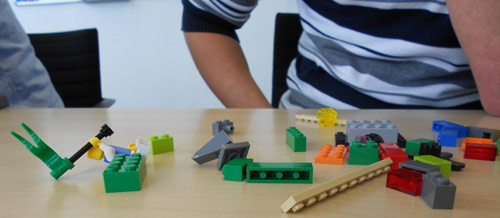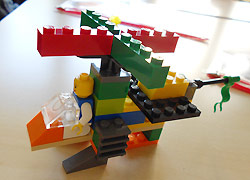Some weeks ago I attended the “StrategicPlay® Fundamentals Facilitator Training” at the StrategicPlay® headquarters and have used elements of LEGO Serious Play™ (LSP) quite some time with teams since then. As a Playmobil® fan it is “shocking” to see how easy you can use LSP for solving complex problems or helping team members to understand each other better. 😉 And additionally it is fun.

LSP’s theoretical background consists of four key elements:
Constructionism, Play, Imagination and Identity. You can dig into the science of LSP by reading this wonderful PDF.
A LSP session can have the following acitivities:
Building a model >> Presenting others your model by telling your story >> Watching and hearing the others presenting their model >> Deconstructing and then building a new model or rebuilding your model…
 By iterating this sequence you are becoming more and more confident about your modeling and story-telling skills. As all participants are building a model about the same subject, you are at the same time sharing knowledge, ideas or problems with the others. After starting with straight-forward subjects (like “Build a tower as high as possible.”) it feels easy to deal with methaphorical subjects (like “Build your perfect team process.”) after some iterations.
By iterating this sequence you are becoming more and more confident about your modeling and story-telling skills. As all participants are building a model about the same subject, you are at the same time sharing knowledge, ideas or problems with the others. After starting with straight-forward subjects (like “Build a tower as high as possible.”) it feels easy to deal with methaphorical subjects (like “Build your perfect team process.”) after some iterations.
I have just started to use LSP with teams, but am convinced, that an experienced StrategicPlay® facillitator can help any team to reveal the true essence of a problem and then find sustainable solutions.
By now I have used LSP in a couple of 2 hour team sessions mainly to discuss their process and their roles within the team. This is only the start. LSP seems to allow infinite options for working with (agile) teams. I am very lucky to have our management sponsoring the LSP Landscape and Identity Set (not available at the moment…), which you definitely need for larger workshops (“We are building our company vision.”). I’m planning to have a Sprint Retrospective with LSP before Christmas and will let you know about my experiences.